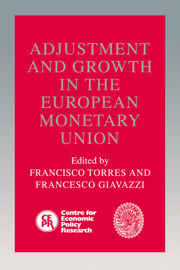Book contents
- Frontmatter
- Contents
- List of figures
- List of tables
- Preface
- List of contributors
- Foreword
- 1 Introduction
- 2 Economic and monetary union: critical notes on the Maastricht Treaty revisions
- Discussion
- 3 The design of optimal fiscal rules for Europe after 1992
- Discussion
- 4 Contracts, credibility and common knowledge: their influence on inflation convergence
- Discussion
- 5 Inflation in fixed exchange regimes: the recent Portuguese experience
- Discussion
- 6 Models of economic integration and localized growth
- Discussion
- 7 Shocking aspects of European monetary integration
- Discussion
- 8 Lessons of Massachusetts for EMU
- Discussion
- 9 Financial and currency integration in the European monetary system: the statistical record
- Discussion
- 10 Currency substitution: from the policy questions to the theory and back
- Discussion
- 11 Coordination of capital income taxes in the economic and monetary union: what needs to be done?
- Discussion
- Index
5 - Inflation in fixed exchange regimes: the recent Portuguese experience
Published online by Cambridge University Press: 29 January 2010
- Frontmatter
- Contents
- List of figures
- List of tables
- Preface
- List of contributors
- Foreword
- 1 Introduction
- 2 Economic and monetary union: critical notes on the Maastricht Treaty revisions
- Discussion
- 3 The design of optimal fiscal rules for Europe after 1992
- Discussion
- 4 Contracts, credibility and common knowledge: their influence on inflation convergence
- Discussion
- 5 Inflation in fixed exchange regimes: the recent Portuguese experience
- Discussion
- 6 Models of economic integration and localized growth
- Discussion
- 7 Shocking aspects of European monetary integration
- Discussion
- 8 Lessons of Massachusetts for EMU
- Discussion
- 9 Financial and currency integration in the European monetary system: the statistical record
- Discussion
- 10 Currency substitution: from the policy questions to the theory and back
- Discussion
- 11 Coordination of capital income taxes in the economic and monetary union: what needs to be done?
- Discussion
- Index
Summary
Introduction
One of the classical problems in macroeconomics is that of how to achieve and maintain a low level of inflation. This problem is thought to have at least one easy solution: a high inflation country can peg its currency to that of a low inflation economy, thereby ‘importing’ a low inflation rate. This textbook advice has been used with success in several countries and in different time epochs. Most recently, France has achieved one of the lowest rates of inflation in the world by pegging the French franc to the Deutschmark.
In an attempt to lower its rate of inflation in order to join the European monetary system (EMS) Portugal has, since October 1990, followed an exchange rate policy that essentially pegs the Portuguese escudo to the ECU. The results of this policy in terms of inflation convergence have so far been disappointing: the rate of inflation has failed to decline by more than 3% since 1990. And instead of simplifying the task of the central bank, the adoption of a fixed exchange rate regime has generated new policy dilemmas. The slow decline of inflation has kept nominal interest rates at high levels that have forced the central bank to impose capital controls.
- Type
- Chapter
- Information
- Adjustment and Growth in the European Monetary Union , pp. 128 - 153Publisher: Cambridge University PressPrint publication year: 1993
- 8
- Cited by



